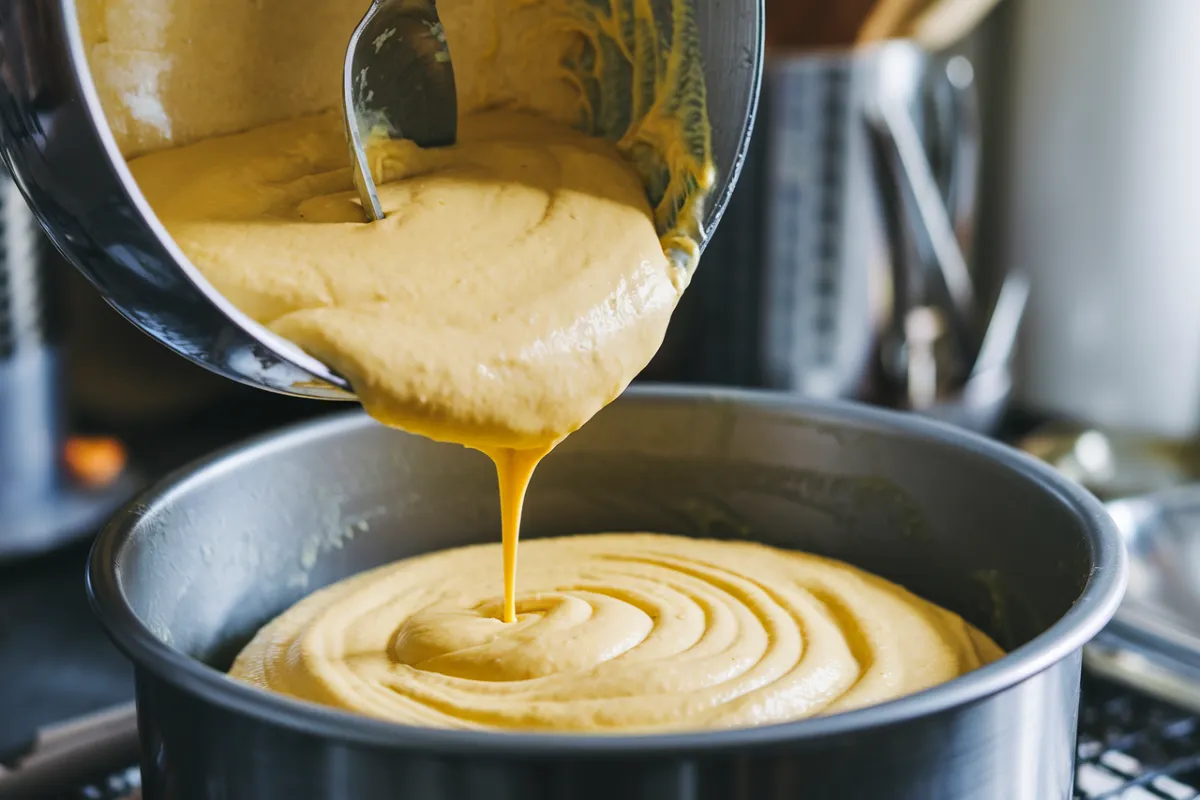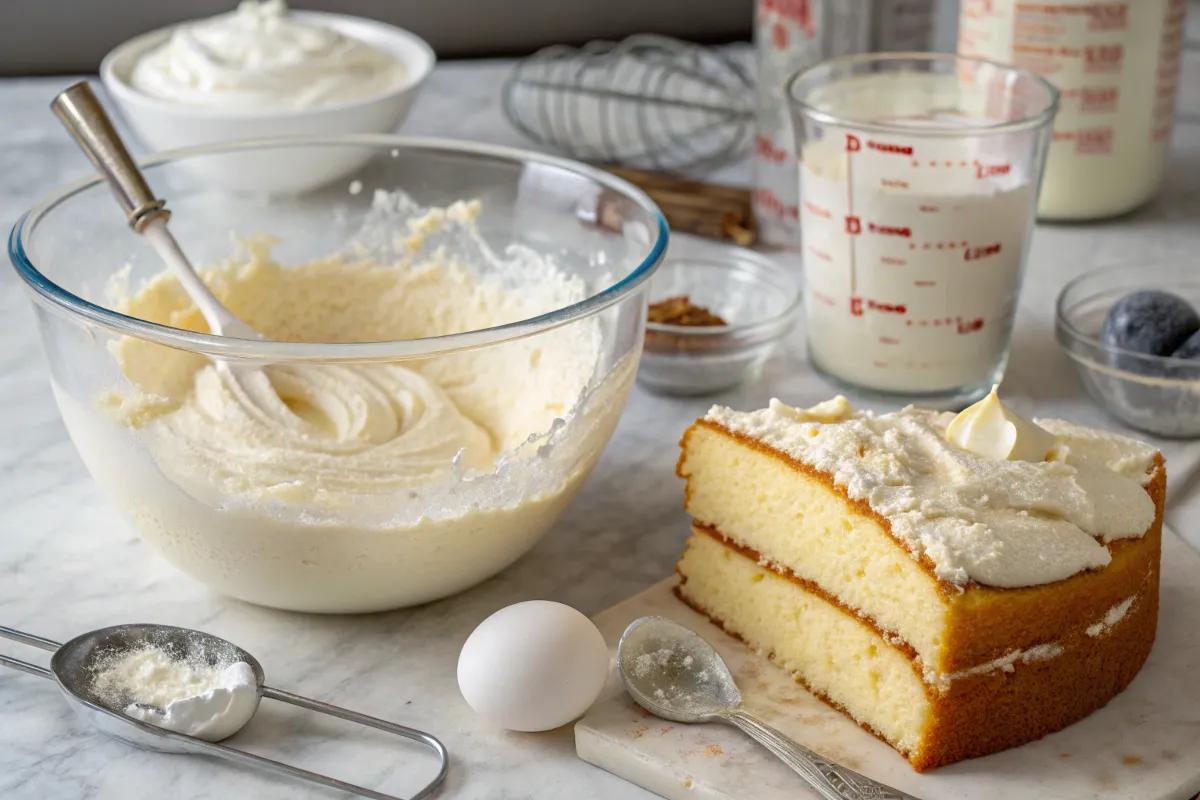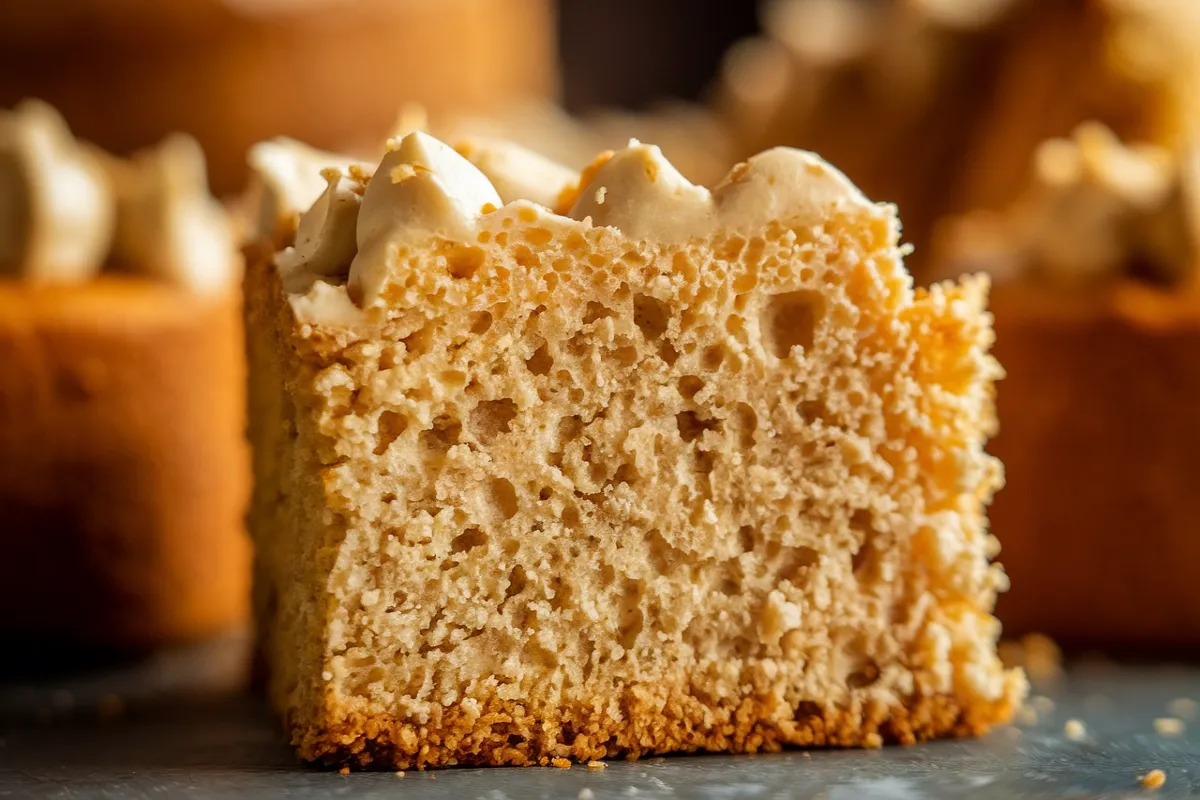This article explores the effects of buttermilk on cake texture and flavor. Learn how it creates moist, tender results and enhances taste.
What Does Buttermilk Do To Your Cake? Exploring Its Baking Magic
Have you ever wondered what does buttermilk do to your cake? It’s a common ingredient, yet many bakers don’t fully understand its role. Consequently, this article will delve into the fascinating ways buttermilk transforms baked goods. For instance, its acidic nature and unique composition have a significant impact on the final product. Understanding what buttermilk does will certainly improve your baking skills. Therefore, let’s explore the magic of buttermilk in cake recipes.
How Buttermilk Affects Cake Texture
Buttermilk’s primary role in baking is improving cake texture. What does buttermilk do to your cake in this regard? For one thing, it creates a wonderfully tender crumb. This is largely due to its acidity. The acid weakens gluten, the protein that gives baked goods their structure. However, the result is a softer and more delicate cake. Moreover, the fats in buttermilk contribute to this tenderizing effect.
The Science Behind Buttermilk’s Texture Magic
Additionally, buttermilk contains lactic acid. This acid reacts with baking soda, helping the cake to rise. Consequently, this reaction produces carbon dioxide, leading to a lighter, fluffier cake. Moreover, what does buttermilk do to your cake differently compared to regular milk? It is that, the acid in buttermilk works wonders, while regular milk does not provide this effect.
Buttermilk’s Role in Cake Moistness
In addition to texture, buttermilk also boosts moisture. What does buttermilk do to your cake concerning hydration? Firstly, it helps create a more moist result, making the cake less likely to dry out. For example, the acidity in buttermilk allows the cake to retain more water. Therefore, cakes made with buttermilk often remain moist for longer periods. Furthermore, the fats in buttermilk contribute to this moisture.
Why Buttermilk Helps Retain Moisture
Furthermore, the proteins in buttermilk also play a role. These proteins help to bind water molecules, preventing moisture loss. Consequently, the cake remains moist and enjoyable. Also, the lactic acid in buttermilk helps to keep a better texture and avoid a cake that is too dense. What does buttermilk do to your cake then? It helps produce a cake that is moist, tender, and delicious.
Does Buttermilk Change the Taste of Cake?
Moreover, buttermilk doesn’t only affect texture and moisture; it also influences flavor. Does buttermilk change the taste of cake? Yes, it does, but in a subtle and pleasant way. Specifically, it adds a slight tanginess. This unique flavor enhances the overall taste of the cake. Furthermore, it balances out the sweetness of the other ingredients. Accordingly, this creates a more complex and delicious flavor profile.
The Subtle Flavor Enhancement
Specifically, buttermilk’s acidity helps to bring out other flavors. For example, it enhances the vanilla or chocolate notes in a cake. Therefore, it’s not just about adding a tangy note; it’s about improving the overall taste. Additionally, what does buttermilk do to your cake in terms of flavor is to make it more interesting. Buttermilk provides a slight depth of flavor that regular milk can’t achieve.
Comparing Buttermilk to Regular Milk in Cakes
However, what does buttermilk do to your cake that regular milk doesn’t? The key difference lies in their compositions. For example, regular milk lacks the acidity and unique fats found in buttermilk. Buttermilk is actually what’s left after butter is churned. Therefore, its composition has different properties. As a result, it provides different baking outcomes. Consequently, regular milk won’t provide the same tenderizing and moisture-enhancing effects.
Buttermilk vs. Milk: The Key Differences
Additionally, buttermilk’s acidity interacts with baking soda, leading to a better rise. Thus, regular milk cannot offer this advantage. What does buttermilk do to your cake in terms of structure and flavor that regular milk simply can’t? It provides a richer texture and a subtle tangy taste. Therefore, choosing buttermilk can significantly enhance your baking results.
Using Buttermilk Substitutes in Baking
However, what if you don’t have buttermilk? Can you still achieve a similar effect? There are a few substitutes that can mimic buttermilk’s properties. Firstly, you can use a combination of milk and lemon juice or vinegar. Specifically, add one tablespoon of lemon juice or vinegar to one cup of milk. Secondly, let it sit for about five minutes, and you have a buttermilk substitute. Furthermore, this mixture adds acidity similar to real buttermilk.
Effective Buttermilk Alternatives
Furthermore, sour cream or yogurt can also be used. Specifically, they provide the necessary acidity and fats for tender texture. However, using these substitutes might slightly alter the flavor. Nonetheless, they are good options when buttermilk is not available. Thus, while buttermilk is ideal, substitutes can often work well. However, what does buttermilk do to your cake still makes it a preferable option.
How Does Buttermilk Affect Baking?
How does buttermilk affect baking overall? In conclusion, buttermilk improves the texture, flavor, and moisture of baked goods. Its acidity tenderizes the gluten, while its fats add moisture. Therefore, buttermilk is an essential ingredient for creating delicious cakes. Additionally, the unique flavor it provides cannot be easily replicated.
Understanding the Impact of Buttermilk
Moreover, what does buttermilk do to your cake compared to other liquid ingredients? It’s not just about adding liquid; it’s about the chemical reactions it triggers. Specifically, the lactic acid interacts with other components, leading to better results. Therefore, if you’re aiming for a perfect cake, buttermilk is often the key. Subsequently, buttermilk does so much more than just adding moisture.
Tips for Using Buttermilk Effectively
Furthermore, here are a few tips for using buttermilk effectively in your recipes. Firstly, use buttermilk that is at room temperature. Similarly, this will help it incorporate evenly into your batter. Secondly, don’t overmix the batter after adding buttermilk. Overmixing can develop the gluten too much, and you don’t want to loose that tender crumb! What does buttermilk do to your cake when mixed properly? It leads to a more delicate texture. Finally, always measure your buttermilk accurately for the best results.
Maximizing the Benefits of Buttermilk
Also, if your recipe calls for baking soda, buttermilk’s acid will react beautifully with it. Moreover, this ensures proper rising. Therefore, what does buttermilk do to your cake becomes even more powerful when paired with baking soda. Furthermore, it helps to balance the flavors in your cake. Consequently, using buttermilk correctly can elevate any baking recipe.
Does Buttermilk Keep Cakes Moist?
Additionally, one of the most common questions is: does buttermilk keep cakes moist? The answer is a definite yes. Buttermilk’s unique properties work together to maintain moisture. Specifically, its proteins help to bind water, preventing it from escaping. Therefore, cakes made with buttermilk remain moist for longer than those made without it. What does buttermilk do to your cake in the long run? It helps keep your baked goods fresh and delicious.
The Long-Lasting Moisture of Buttermilk Cakes
Moreover, the acid in buttermilk also helps with moisture retention. What does buttermilk do to your cake over time? It creates a cake that is not only moist when fresh from the oven, but remains moist for days. Subsequently, the fat content of buttermilk contributes significantly to a moist end result. Consequently, using buttermilk is a great way to make sure that your cake does not become dry.
Buttermilk in Different Cake Recipes
Furthermore, buttermilk is a incredibly versatile ingredient. It can be used in many different types of cake recipes. For example, it works well in vanilla cakes, chocolate cakes, and even fruit cakes. What does buttermilk do to your cake in these different contexts? It enhances the flavor and texture of each. Moreover, it can be used in both simple and complex cake recipes.
Versatility of Buttermilk in Baking
Moreover, it complements a wide range of flavors, therefore making it great for experimenting in the kitchen. For instance, try it in a lemon cake or a spice cake. You will be surprised by how buttermilk improves the overall taste. What does buttermilk do to your cake, regardless of the recipe? It makes it tastier and more tender. Thus, the magic of buttermilk is not limited to just one or two kinds of recipes.
The Final Word on Buttermilk and Cake
In conclusion, what does buttermilk do to your cake is a question with many answers. It tenderizes the gluten, provides essential moisture, enhances flavor, and helps with rising. Consequently, buttermilk transforms your baking in remarkable ways. Subsequently, the unique properties of buttermilk make it an essential ingredient for any baker looking for the perfect cake. Therefore, adding buttermilk to your recipes is a simple yet effective way to improve your baked goods. Specifically, the effect buttermilk has on a cake is truly extraordinary.
Exploring the Variations of Buttermilk Usage
Furthermore, consider how variations in the type of buttermilk used can affect outcomes. Full-fat buttermilk will provide the richest texture and most moisture, whereas low-fat options will be lighter. What does buttermilk do to your cake will therefore depend on the buttermilk you use! Also, some recipes may call for cultured buttermilk, which has a more pronounced tang. Hence, it’s important to pay attention to the details of the recipe you’re using.
Choosing the Right Buttermilk
Additionally, homemade buttermilk substitutes work well, but always keep the texture of the alternative in mind. For example, sour cream adds a creamier note, while yogurt makes the cake more dense. What does buttermilk do to your cake when using an alternative? It might slightly alter the final taste and texture, but often these variations can still produce a delicious result. Therefore, choose buttermilk or an alternative to suit your particular needs and flavor preferences.
Common Misconceptions About Buttermilk
Also, there are a few common misconceptions about buttermilk. For one, some people believe it’s a high-fat option, when it’s actually quite lean, in most cases. What does buttermilk do to your cake is not because of excessive fat. Additionally, others assume it is high in calories, but it’s similar to regular milk in that aspect. Therefore, it’s important to consider the actual composition of buttermilk.
Debunking Myths
Furthermore, some might think that buttermilk always adds a strong tangy flavor. However, the tang is generally very subtle and well-balanced. What does buttermilk do to your cake in terms of taste depends also on the other ingredients in your recipe. Thus, it complements flavors rather than dominating them. Therefore, understanding these facts about buttermilk will help you use it with more confidence.
Advanced Baking Techniques with Buttermilk
Moreover, let’s consider some advanced baking techniques. Buttermilk can be used in complex recipes. For example, it is often seen in red velvet cakes. What does buttermilk do to your cake in this specific recipe? It provides that signature tang and deep red color. Furthermore, the acidity of buttermilk helps the cocoa react better, making the red color more vibrant. Thus, it goes beyond just basic cake recipes.
Buttermilk in Red Velvet Cake
Additionally, buttermilk also contributes to the moistness of red velvet cakes. Therefore, it’s an essential part of what makes this cake so special. Similarly, what does buttermilk do to your cake in this case, and others? It creates a specific texture and flavor that cannot be obtained with any other ingredient. Specifically, the balance it brings is invaluable. Consequently, buttermilk is a key element for more advanced cake creations.
Buttermilk in Layer Cakes
When creating layer cakes, buttermilk is particularly beneficial. What does buttermilk do to your cake in terms of structural integrity? It adds moisture without making the cake too heavy. This means you can create taller, more impressive layer cakes. Additionally, buttermilk’s ability to create a tender crumb prevents the cake from becoming dense. It also helps the cake layers to bake evenly.
The Benefits in Layered Treats
Moreover, if you are making a layered cake, buttermilk is the best choice, therefore helping you ensure that your layers are uniform in height and consistency. Therefore, what does buttermilk do to your cake in a tiered format? It ensures a stable structure and a moist, tender experience for every bite. Subsequently, it is a game changer for any multi-layered cake.
How Buttermilk Enhances Chocolate Cakes
Furthermore, buttermilk is amazing for chocolate cakes. What does buttermilk do to your cake in chocolate recipes? It deepens the chocolate flavor. Consequently, the acid helps to bring out the richness of the cocoa. Additionally, it creates a wonderfully moist and tender texture. Therefore, buttermilk is often the secret ingredient for an incredible chocolate cake.
Maximizing Chocolate Cake Flavor
Moreover, buttermilk helps to balance the sweetness of the chocolate, therefore making it a more refined final flavor. What does buttermilk do to your cake when combined with chocolate? It creates a complex flavor profile that is both rich and satisfying. Thus, buttermilk can elevate a basic chocolate cake into a culinary masterpiece. Specifically, the result is simply delicious.
Buttermilk in Vanilla Cakes
Conversely, buttermilk is also a wonderful addition to vanilla cakes. What does buttermilk do to your cake in a vanilla focused recipe? It enhances the subtle flavor of vanilla. Furthermore, it prevents the cake from being too sweet or bland. Moreover, the slight tang from buttermilk gives the cake a lovely, balanced flavor.
Balancing Flavor Profiles
Additionally, using buttermilk in vanilla recipes will often result in a more nuanced final product. Specifically, what does buttermilk do to your cake is to provide a perfect canvas for the vanilla flavor. Therefore, the subtle tangy note and perfect texture help the vanilla to shine. In conclusion, buttermilk brings vanilla cakes to the next level.
Buttermilk and Baking at Different Altitudes
When baking at higher altitudes, buttermilk can be even more essential. What does buttermilk do to your cake at altitude? It helps to counteract the effects of the lower air pressure. Specifically, the extra moisture helps to prevent dryness. Furthermore, the acid aids in proper leavening and prevents the cake from rising too quickly, then collapsing.
Baking at Higher Elevations
Moreover, buttermilk’s unique properties help to create a cake that is still light, moist, and enjoyable. Consequently, what does buttermilk do to your cake at high altitudes is truly helpful, especially to reduce the issues that many bakers face. Therefore, buttermilk is beneficial for everyone, but more so for those baking at higher locations. Hence, it can transform challenging baking situations into successes.
The History of Buttermilk
Furthermore, let’s explore the history of buttermilk. Originally, buttermilk was the liquid leftover after churning butter. What does buttermilk do to your cake today is not how it was used in the past. In the past, it was a byproduct, not a sought after baking ingredient. This is because it was a highly perishable liquid. However, today’s buttermilk is often cultured, providing a more consistent product.
From Byproduct to Baking Star
Additionally, the use of buttermilk in baking evolved over time. Bakers recognized the unique properties it had for improving both texture and flavor. Consequently, it went from a simple waste byproduct to a star ingredient. Therefore, what does buttermilk do to your cake today is a product of years of culinary experiments. It has certainly become indispensable in baking.
Buttermilk and Gluten-Free Baking
Also, buttermilk has a unique effect in gluten-free baking. What does buttermilk do to your cake when the gluten is missing? Specifically, it helps to add moisture and tenderness to gluten-free baked goods. Gluten-free recipes often need additional support to achieve a good crumb. Moreover, the slight tang of buttermilk can improve the taste of gluten-free cakes.
Helping Gluten-Free Cakes
Furthermore, the absence of gluten can often result in a dry, crumbly texture, which is why buttermilk becomes even more essential. Thus, what does buttermilk do to your cake when it is gluten-free? It can be a game-changer for improving the final outcome. Subsequently, using buttermilk is a strategy that all bakers should try.
Storage and Handling of Buttermilk
Finally, understanding the proper storage of buttermilk is important. Specifically, buttermilk should be stored in the refrigerator to remain fresh. Unopened, it can last for several weeks, however, once opened, it should be used within a few days. What does buttermilk do to your cake if it’s not fresh? It can impact the flavor and texture negatively.
Tips for Keeping Buttermilk Fresh
Moreover, you can also freeze buttermilk, therefore making it usable for later use. Additionally, freezing is best in portions that are easy to use. Therefore, what does buttermilk do to your cake will be maximized if you follow proper handling and storage. Consequently, taking these steps will ensure that your buttermilk is always at its best when you are baking.
Frequently Asked Questions (FAQs)
What is the benefit of buttermilk in cake?
The main benefit of buttermilk is that it tenderizes gluten, which results in a softer cake. Moreover, it adds moisture and helps the cake remain moist for longer. Additionally, it improves the overall flavor with a mild tang and enhances other flavors in the cake.
Does buttermilk change the taste of cake?
Yes, buttermilk adds a subtle tangy flavor to cakes. This enhances the overall taste and balances out sweetness. Moreover, this slight tanginess makes cakes more interesting. The flavor is not overpowering but complements the other ingredients.
How does buttermilk affect baking?
Buttermilk’s acidity reacts with baking soda, promoting a lighter texture and a better rise. The acid in buttermilk also helps tenderize gluten, resulting in a more delicate crumb. Furthermore, the fats and proteins in buttermilk add moisture and help the cake stay moist.
Does buttermilk keep cakes moist?
Yes, buttermilk helps keep cakes moist because it retains more water. Furthermore, the proteins in buttermilk bind to water molecules, preventing them from evaporating. Consequently, cakes made with buttermilk will be moist for a longer period of time than those made with regular milk.



